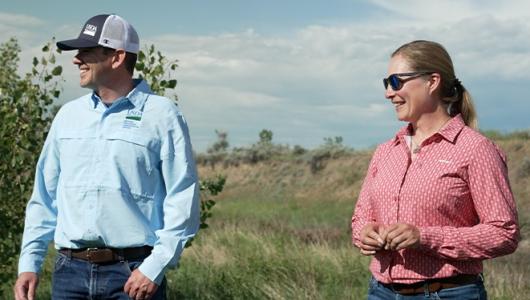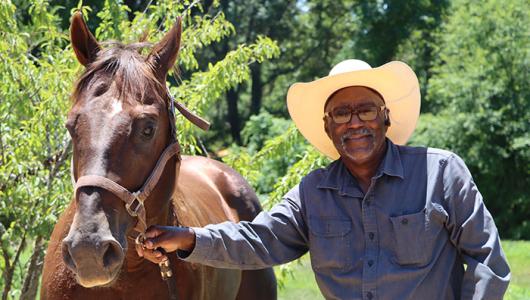In the last 50 years, populations of the northern bobwhite quail have decreased by 85 percent in the United States. Loss, degradation and fragmentation of habitat on a continental scale has largely silenced the iconic species across rural America.
Tall Timbers – through its research and land management – as well as a network of conservation partners are working together to help this species rebound.
Read the interactive, multimedia version of this story.
Sportsmen were alarmed, and landowners worried as they watched the northern bobwhite population plummet at the turn of the century. In the last 50 years, annual populations decreased by 85 percent in the United States. Loss, degradation and fragmentation of habitat on a continental scale has largely silenced its iconic call across rural America.
In Florida, a former hunting plantation is leading the way to bring quail back. At Tall Timbers, a research station and land conservancy, scientists study fire and its effect on quail and wildlife on the nearly 4,000-acre property listed on the National Register of Historic Places.
History
The Tall Timbers story began when the plantation owner, Henry L. Beadel, befriended the renowned naturalist Herbert Stoddard, who had been brought to the area to investigate the declining quail populations in the early 1900s. Stoddard’s research revealed that improper application of fire had destroyed the bird’s habitat. His conclusion was at odds with the land management agencies of his day, and the results were suppressed. In 1958, Beadel bequeathed his land so that scientific research on fire ecology would not be subject to censorship.
Today, scientists there study fire ecology, native plant communities, longleaf pine, ornithology, herpetology and invertebrates. Tall Timbers is providing solutions to the threats that face quail as well as other fire-dependent wildlife in the southeast.
Dr. Theron Terhune is carrying on Stoddard’s legacy. The game bird program director is a modern academic and an old school outdoorsman. He crafts his own hunting arrows and
hand-ties fishing flies while he deploys modern technology to investigate the topics founded by Stoddard.
“He was a phenomenal naturalist and astute observer. It blows my mind how he didn’t have any of the gadgets or high-tech tools we do, but he was right more than not,” Theron says. Wildlife experts reference Stoddard’s 1931 book, The Bobwhite Quail: Its Habits, Preservation and Increase, as the “quail bible.” Theron says he re-reads it once every two or three years to keep his current work grounded.
“Stoddard largely worked with private landowners, putting boots on the ground, conducting research and making observations rather than posted in a university office. That model is still important today, providing landowners a direct line to the information they need to better manage and have more quail,” he says.
So far, Theron has created a quail hunting app called Birds Up, quail monitoring Quail Trax App, and the Invasive Tracker App.
Theron and his staff collect insect samples and monitor cotton rats, snakes, avian predators such as hawks and meso mammals that include raccoons, opossums, fox and skunks. “They are all interconnected,” he says. When cotton rat numbers go up, so do quail. Understanding the predator-prey dynamics helps explain quail demographics and population cycles.
Understanding how timber and fire management influence vegetation, composition, diversity and structure helps inform best management practices for bobwhite quail.
“For us, our biggest knowledge gap is chick ecology, from the time of hatching to three months of age,” he says. On average, only 36 out of 100 chicks make it to three months, and if they can improve that number by 10-15 percent, they will realize significant gains towards recovery overall. His wife, Dr. Heather Terhune, is a veterinarian and helped Theron develop a procedure to suture tiny radio transmitters onto 12-day-old chicks to study the factors affecting their survival. Paring these data with miniature solar-powered GPS units on parents and drone technology to capture spatial data will advance chick ecology and habitat management.
Research Cycle
Call count surveys in October and early November count coveys and estimate quail density as they broadcast the less familiar vocalization, the “koilee” call, about 20 minutes before sunrise. The covey call establishes home-range territories and helps quail relocate each other after they have been scattered by predators.
Biologists, technicians and students capture adult birds three times a year in November, January and March to band and put radio collars on them for research projects and obtain demographic information. The goal is to capture and tag 30-50 percent of the annual population.
After spreading bait for a couple of weeks, game bird lab manager Diana McGrath and technicians trap birds for two to four weeks. She leads her staff out on ATVs after dark to take the quail out of the traps and bring them back to the lab in transport boxes.
Early the next morning, they work fast, checking and recording data on each bird about its condition, sex and age, weight, and uniquely numbered leg band. Radio collars are custom fitted onto a designated number of birds. Staff stuff the quail into the boxes and release them back into the areas where they were captured. Radio telemetry helps researchers collect data on quail behavior, habitat use and survival rates.
In June, July, and August, the radio collars on adult birds tell biologists where the quail are nesting. The nests are monitored until the chicks are 12 days old and can be captured for research.
Diana and her staff hike into the forest at 3:30 a.m. while the birds are still resting and erect a corral surrounding the brood-roosting area. When dawn breaks, they begin pulling all the vegetation in the enclosed area, working from the corral edge to the brood-roosting location.
As the technicians close in, the quail scatter and they scramble to catch the chicks and carefully place them into pillow cases. Each bird is marked with a wing tag. A few chicks get tiny radio transmitters as part of the new research to shed light on those vulnerable first few months of life.
As nesting ends with the onset of fall, the quail population is at its peak and ready for the survival challenges of the winter. Roughly 80 percent of the adult quail population dies each year, highlighting the need for high reproduction and the habitat to support it.
Good Habitat
What is a good habitat? A diverse mix of vegetation comprised of about one-third forbs and legumes, one-third grasses, and one-third low, woody species.
Bobwhites require frequently burned open pine savannas and grasslands for foraging, nesting, brood-rearing and escape cover. A properly managed timber stand with an open canopy allows sunlight on the ground to grow the appropriate mix of plants.
Clumps of bunch grasses such as bluestems, Indian grass and wiregrass make excellent nesting sites. Forbs such as ragweed, partridge pea and beggar tick provide food, cover and the bare ground essential for travel and finding seed. Shrubby areas with plants such as green briar, blackberry, plum thickets and oak scrub give quail roosting and escape cover from predators.
When restoring the land doesn’t bring quail back, Theron and his team have perfected the technique of capturing and transporting wild birds to create population hubs in select locations. Birds raised in captivity and released have very low survival rates, with less than 3 percent living to breeding season. Through the translocation of wild birds, Tall Timbers has recovered wild quail on 70,000 acres of private land in the Southeast coastal range from Florida to New Jersey.
“Too often people look for a panacea to bring quail back. But the range-wide reduction of bobwhite did not occur overnight and was not attributed to just one thing, but rather a collective change in land-use practices. Bringing them back is going to take intentional management, plenty of resources, collaborative effort and dedication,” he says.
Private property makes up almost 70 percent of the land in the United States. Conservationists could never set aside enough public land to reverse the species decline, says Don McKenzie, director of the National Bobwhite Conservation Initiative, established in 2002 to coordinate state recovery plans for the game birds. “Farm Bill programs focused on private, working lands are essential to the bird’s recovery,” he says.
Through Farm Bill programs, USDA’s Natural Resources Conservation Service (NRCS) helps agricultural producers restore quail habitat on private lands.
The northern bobwhite quail is a nationally identified target species of the Working Lands for Wildlife (WLFW) partnership, which provides technical and financial assistance through the Environmental Quality Incentives Program (EQIP) to restore their habitat. The gopher tortoise is also targeted in this program and helps landowners develop habitat that also benefits quail.
NRCS is working to restore longleaf pine across its historic range – from Texas to Virginia – through the Longleaf Pine Initiative. Assistance provides planning and cost share to help implement conservation practices that restore quail habitat, such as prescribed burning, timber stand thinning, planting longleaf pine and removing invasive plants.
Since 2008, Tall Timbers has used NRCS programs to control 187 acres of invasive species, prescribe burn 5,424 acres and plant 47 acres of longleaf pine. “They are getting the job done on a regional setting,” says Steve Tullar, NRCS district conservationist. “They have the best management in the Southeast for the bobwhite quail," he says.
Working Lands for Wildlife: Quail
The Working Lands for Wildlife partnership combats the decline of wildlife species where it can be reversed and the recovery benefits other species with similar habitat needs.
Longleaf Pine Project Area
NRCS works with landowners to restore longleaf pine across its historic range from Texas to Virginia.
Agricultural producers in the shaded areas can receive higher priority for financial and technical assistance to improve habitat for northern bobwhite quail.
Working Lands for Wildlife: Gopher Tortoise
The Working Lands for Wildlife partnership combats the decline of wildlife species where it can be reversed and recovery benefits other species with similar habitat needs.
Agricultural producers in the shaded areas can receive higher priority for financial and technical assistance to improve habitat for gopher tortoise, the keystone species of pine forests in the South. Habitat for the gopher tortoise also benefits northern bobwhite quail.
It's Not Just Quail
The quail’s well-being indicates the fate of other at-risk and endangered species. Bobwhite conservation promotes habitat beneficial to numerous species such as the gopher tortoise, eastern indigo snake, southeastern American kestrel, red- cockaded woodpeckers, tiger salamanders, indigo buntings, Florida grasshopper sparrow, Bachman’s sparrow, eastern meadowlark and diamondback rattlesnakes.
“If we lose quail, we will lose a host of species,” Theron says.
You can find more information from:


